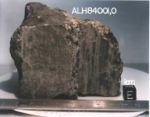Extraterrestrial life
Extraterrestrial life, if such a thing existed, would include any life form originating away from the earth.
Contents
Extraterrestrial life as a scientific hypothesis
Serious speculation on extraterrestrial life has centered on two possibilities: exogenesis of life and the possibility of prior or future contact with an extraterrestrial nation-state.
Microbes and other primitive forms
With the continued development and perfection of telescopes, astronomers and rocket scientists have openly and often feverishly speculated about whether the other planets in our solar system might harbor forms of life that originated on those planets. This speculation has also extended to Titan, the largest satellite of the planet Saturn.
The major considerations driving such speculation are the requirements of life, and the difficulty with the theory of abiogenesis as a workable origin of life on earth. Most scientists engaged in such speculation seem to agree that life requires at least two things in order to self-generate in any environment:
- 1. Water
- 2. An atmosphere
Currently the most exciting subject for speculation concerning extraterrestrial life is the planet Mars. Its atmosphere is quite thin, and this would militate against the presence of life or, more to the point, the presence of standing or flowing water. But photographs taken from orbit and from the surface of Mars reveal erosion channels that strongly suggest that water once flowed on Mars. Indeed, the first graphic above shows changes in a gully in two views of it, taken four years apart--as if liquid water had opened another erosion channel in the meantime. (The operators of the Mars Global Surveyor insist that such pictures might still contain artifacts that make them unsuitable for scientific research, and hence disclaim any definite conclusion that anyone might be tempted to draw from them.) The second graphic shows a meteorite containing microscopic cavities that once might have held microbes and that, until recently, was believed to have fallen to earth from Mars.
If one could show that abiogenesis occurred on Mars, then that process was far more likely to have occurred on earth than it would be absent such a showing or finding. Yet apart from the reliability of such evidence is this one inherent weakness for this argument: it assumes that life found on Mars originated on Mars. The Hydroplate theory of the Great Flood suggests that large quantities of water, including muddy slurries, were ejected into space during the initial fissure of the original earth's crust, and that these ejecta persist today as comets, asteroids, and meteoroids. If such ejected water and mud fell to Mars from above, then they might have held microbes--and therefore any microbes found on Mars are far more likely to have come from earth during the Noachic Flood than to have originated on Mars.
(Note: if such life forms survived, that need not be a great shock to any observer. Extremophiles, or microbes known to thrive under conditions that would kill or render dormant any other form of life, are well-known on earth and have even been the subject of engineering studies attempting to find practical uses for them.)
Extraterrestrial Nation-States
Do one or more extraterrestrial nation-states exist? In fact, a project called SETI, for Search for Extra-Terrestrial Intelligence,[1] has existed for years. Their astronomers use radiotelescopes to search a defined frequency band that, they believe, is the likeliest region in the electromagnetic spectrum for anyone to be sending a signal intended to cross interstellar, or even intergalactic, space.
Furthermore, Francis Crick and Leslie Orgel, in 1973,[2] openly speculated on a form of exogenesis called directed panspermia, in which such an extraterrestrial nation-state fired a brace of missiles, each laden with bacteria and/or blue-green algae, in all directions. One such missile crashed on earth, and we are its by-product, as it were, their theory states. For a detailed discussion on the logical weaknesses of such a position, see the main article on Panspermia.
Politicians (among them, former President of the United States Jimmy Carter) have openly speculated on the existence of extraterrestrial nation-states.[3] For further details, see the main article on Exotheology.
Extraterrestrial Life: Likelihood
The scientific literature, and the popular culture, are rife with anecdotes purporting to testify to the existence of extraterrestrial life, both microbial and "intelligent"--that is, capable of building a civilization and a nation-state and possibly a vast military command. Stories of unidentified flying objects abound, and indeed the United States Air Force investigated the possibility directly over a period of twenty-two years.[4][5][6]
However, no definitive evidence exists that these objects are anything other than misinterpreted weather phenomena or perhaps super-secret military aerospace prototypes. Neither has any astronomer or astronaut reported a definite sighting of, much less contact with, any carrier-like vessel that would have been capable of launching any of the alleged two-seater or similar small-crewed craft that various "witnesses" report having encountered. Nor has any physicist yet suggested a method by which such a craft could have visited our solar system, given the fixed speed limit set by the Special Theory of Relativity.
Nor has any microbiologist demonstrated the finding of microbes having a definite extraterrestrial origin.
Extraterrestrial Life in Science Fiction
Extraterrestrial nation-states and, almost as often, extraterrestrial microbes, have been a staple of science fiction since soon after science-fiction writers first began speculating on what sort of inventions might carry men into outer space, and what they might discover there. H. G. Wells even speculated on an extraterrestrial nation-state on the moon--a kingdom peopled, if that is the right word, by man-sized insects (The First Men in the Moon). Wells also speculated that the Martian nation-state would launch an invasion of earth (The War of the Worlds), an invasion that would fail when the Martian soldiers and pilots fell terminally ill with earthly microbes against which their immune systems would have no defense. Edgar Rice Burroughs indulged in far richer speculation on an entire civilization on Mars, and on semi-regular commerce between his Martians and a select few visitors from earth.
The middle twentieth century saw the introduction of a number of popular-culture icons that were either:
- Humans caught up in events on other, inhabited worlds, some of which were making war against the earth, or
- An extraterrestrial "refugee" that became an obvious God-substitute after, Moses-like, he crashed to earth in a small space capsule launched from a world that later destroyed itself in a cataclysm far more devastating than the Great Flood had been.
In addition to this, the motion picture industry, especially in the United States but also in Great Britain, produced scores of low-budget films having a theme involving an extraterrestrial nation-state attempting either:
- To recruit humans, usually by fraudulent means, into assisting them in weapons or defensive-systems development,
- To subvert human society and/or the international community by infiltration or by playing some individual humans or human nation-states against others, or:
- To invade the earth by main force.
The motion picture industry abandoned that theme as the century progressed, and produced a number of films showing extraterrestrials to be friendly. Toward the very end of the century, the theme of extraterrestrial invasion returned, in the form of a number of high-budget films that linked the basic theme to a number of modern-day legends, including:
- The alleged crash of an extraterrestrial scout craft near Roswell, New Mexico, United States.
- The synthetic religion, called Scientology, which the late science-fiction author L. Ron Hubbard developed literally on a wager.
The Star Trek television franchise that Gene Roddenberry created, with its myriad of extraterrestrial and often trans-galactic nation-states and empires hardly needs introduction. But in addition, producer Quinn Martin created a series that centered on one man's attempt to warn his government that certain people were not what they appeared, but were instead extraterrestrial spies.
Nor have science fiction writers ignored speculation on the finding of extraterrestrial microbes. Usually they have portrayed such microbes as capable of producing deadly extinction-level pandemics. (See, for example, The Andromeda Strain by Michael Crichton.) John B. Olson and Randall S. Ingermanson, however, speculated that the first crew to fly to Mars might discover incontrovertible evidence of microbial life--including a culturable microbe. This would engender excitement in the hearts of their launch authorites, but would also inspire such fear in the mind of a NASA engineer that she would actually attempt to strand or murder the crew to stop them from back-contaminating the earth with their culture.
The Bible and Extraterrestrial Life
An extraterrestrial nation-state or civilization, or any race of beings capable of forming such an institution, would be incompatible with the Bible. The presence of such a race would give the lie to the claim of Jesus Christ that He came to take away the sin of the world.[7], and that He died once and only once to bring this about. The only Kingdom that is not of this earth is the Kingdom of Heaven[8]--and that Kingdom is also not of this universe, or "cosmos".
However, the presence of extraterrestrial microbes on one or more of the other planets in our solar system (most likely Mars) would not be incompatible with the Bible. For example, if the hydroplate theory is correct and a slurry of mud from the Great Flood traveled to Mars and poured itself out upon it, then such a slurry would almost certainly contain microbes. That some of these might be extremophiles, and thus capable of long-term survival even in such a harsh environment as that of Mars, is entirely possible and would allow complete harmony between the finding of microbes in such locations and the Biblical account of earth pre-history.
References
- ↑ Home of the SETI Institute
- ↑ Crick, F. H. C., and Orgel, L. E. "Directed Panspermia," Icarus, 19, 341 (1973).
- ↑ Carter claims to have witnessed an unidentified flying object in 1969; he remains the only U.S. President to have formally reported a UFO. He filed a report with the International UFO Bureau in Oklahoma City after a request from that organization.[1] See Jimmy Carter.
- ↑ Anonymous, "Project Blue Book", UFO Evidence.org, retrieved April 16, 2007
- ↑ Anonymous, The Project Blue Book Archive, retrieved April 16, 2007
- ↑ Fund for Unidentified Flying Object Research (FUFOR), Official Site of the National Investigative Committee for Aerial Phenomena, Francis L. Ridge, editor and Webmaster, December 15, 1997 to present. Retrieved April 16, 2007.
- ↑ I_John 2:2 (NASB)
- ↑ [Citation Needed]

